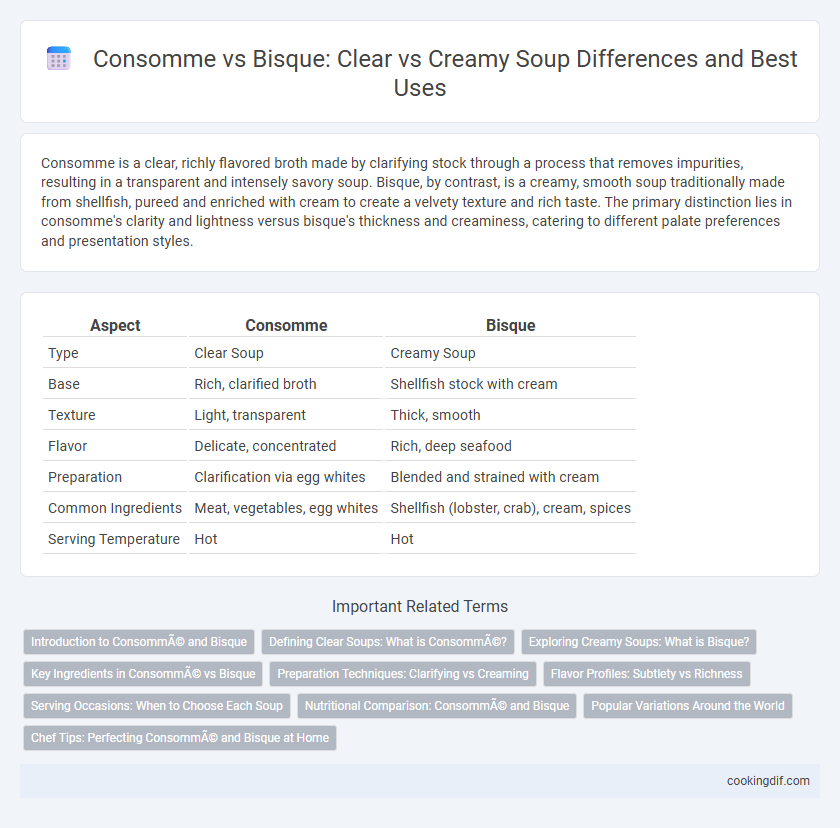Consomme is a clear, richly flavored broth made by clarifying stock through a process that removes impurities, resulting in a transparent and intensely savory soup. Bisque, by contrast, is a creamy, smooth soup traditionally made from shellfish, pureed and enriched with cream to create a velvety texture and rich taste. The primary distinction lies in consomme's clarity and lightness versus bisque's thickness and creaminess, catering to different palate preferences and presentation styles.
Table of Comparison
| Aspect | Consomme | Bisque |
|---|---|---|
| Type | Clear Soup | Creamy Soup |
| Base | Rich, clarified broth | Shellfish stock with cream |
| Texture | Light, transparent | Thick, smooth |
| Flavor | Delicate, concentrated | Rich, deep seafood |
| Preparation | Clarification via egg whites | Blended and strained with cream |
| Common Ingredients | Meat, vegetables, egg whites | Shellfish (lobster, crab), cream, spices |
| Serving Temperature | Hot | Hot |
Introduction to Consommé and Bisque
Consomme is a crystal-clear, richly flavored broth made by clarifying stock through simmering with egg whites, which trap impurities and produce a clean, refined presentation ideal for light appetizers. Bisque is a smooth, creamy soup traditionally crafted from shellfish shells, pureed vegetables, cream, and aromatic spices, offering a velvety texture and intense, rich flavor profile. The fundamental difference lies in consomme's transparency and purity versus bisque's thick, creamy consistency and robust taste.
Defining Clear Soups: What is Consommé?
Consomme is a type of clear soup known for its crystal-clear appearance and rich, concentrated flavor achieved through a slow simmering process that clarifies the broth by removing impurities and fat. It typically uses beef, chicken, or veal stock, combined with egg whites, ground meat, and vegetables to create a raft that traps particles, resulting in an intensely flavorful and visually transparent soup. This refined clarifying technique distinguishes consomme from creamy soups like bisque, which are thickened and enriched with cream or pureed ingredients.
Exploring Creamy Soups: What is Bisque?
Bisque is a rich, creamy soup traditionally made from shellfish like lobster, crab, or shrimp, known for its smooth texture and deep seafood flavor. Unlike consomme, which is a clear, highly clarified broth, bisque incorporates cream and is thickened with rice or roux to achieve its luxurious consistency. This savory, velvety soup highlights the essence of shellfish and is often finished with cream or brandy to enhance its rich, indulgent profile.
Key Ingredients in Consommé vs Bisque
Consomme features clarified broth made from richly flavored stock, egg whites, and mirepoix, resulting in a clear and intensely savory soup. Bisque relies heavily on pureed shellfish or vegetables combined with cream, butter, and a touch of brandy or wine, creating a smooth, velvety texture and rich flavor. The primary distinction lies in consomme's transparency and clarity versus bisque's creamy, thick consistency driven by dairy and puree components.
Preparation Techniques: Clarifying vs Creaming
Consomme is a clear soup achieved through a meticulous clarifying process involving simmering meat, vegetables, and egg whites to trap impurities, resulting in a transparent and intensely flavored broth. In contrast, bisque is a creamy soup prepared by pureeing shellfish or vegetables with cream and often thickened with rice or roux, creating a rich, velvety texture. The key difference lies in consomme's purification technique versus bisque's emulsification and creaming methods.
Flavor Profiles: Subtlety vs Richness
Consomme offers a clear broth with a delicate, refined flavor profile that highlights subtle, savory notes from carefully simmered meat and vegetables. Bisque delivers a creamy, rich taste with a velvety texture, often infused with shellfish or seafood, providing layers of bold, intense flavors. Choosing between consomme and bisque depends on whether the desired soup emphasizes light clarity or deep, luxurious richness in taste.
Serving Occasions: When to Choose Each Soup
Consomme is ideal for formal dinners and elegant appetizers due to its clear, rich, and refined presentation that sets a sophisticated tone. Bisque suits casual gatherings and festive occasions, offering a creamy, flavorful experience perfect for warming guests and complementing hearty dishes. Choosing consomme enhances a polished menu, while bisque brings comfort and indulgence to the table.
Nutritional Comparison: Consommé and Bisque
Consomme, a clear, highly concentrated broth made from clarified stock, is low in calories and fat while providing protein and essential minerals like potassium and magnesium. Bisque, a creamy soup traditionally made with shellfish, contains higher calories and fat due to cream and butter, but offers valuable nutrients such as omega-3 fatty acids, vitamin A, and calcium. Choosing between consomme and bisque depends on dietary preferences for lean, hydrating nourishment versus rich, nutrient-dense indulgence.
Popular Variations Around the World
Consomme, a crystal-clear soup made from richly flavored stock, is popular in French cuisine and often served chilled or hot with garnishes like julienned vegetables or herbs. Bisque, a creamy and smooth soup traditionally made from crustaceans such as lobster, crab, or shrimp, is prevalent in coastal regions worldwide, including Louisiana's famous crawfish bisque and Mediterranean versions with shellfish purees. Global variations emphasize consomme's clarity and depth of flavor, while bisques showcase richness and velvety texture through the use of cream and seafood.
Chef Tips: Perfecting Consommé and Bisque at Home
Consomme, a crystal-clear soup made by clarifying rich stock with egg whites, requires precise temperature control to achieve its delicate clarity and deep flavor. Bisque, a creamy, smooth soup traditionally made from shellfish, benefits from slow simmering and careful blending to develop its luxurious texture and intense taste. Chefs advise skimming impurities for consomme and gradually incorporating cream for bisque to perfect these classic soups at home.
Consommé vs Bisque for clear vs creamy soup Infographic

 cookingdif.com
cookingdif.com